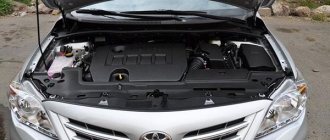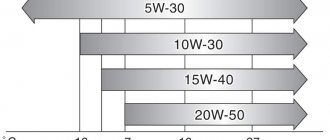Toyota Land Cruiser Prado cars are not only in great demand, but also greatly respected.
This is a large SUV with good technical characteristics, reliable power units, a comfortable interior and impressive durability.
That’s why even samples from the 90s are still in demand, are in excellent condition and can compete with many modern cars.
Operating conditions affect the frequency of engine oil changes in Toyota Land Cruiser Prado.
Objectives of motor oils
But in order for the machine to serve for a long time and efficiently, it requires appropriate care. One of the main conditions for maintaining engine performance is the timely replacement of engine and transmission oils and other consumables.
Not every car owner knows what oils to pour into a Toyota Prado 150 with a diesel engine, which is why problems often arise and require contacting a car service center. Maintaining such a car is not cheap, so every visit to a service station costs the owner a large sum.
Timely replacement and competent selection of engine oil for a Toyota Prado allows you to:
Choose among these manufacturers, based on the recommended characteristics of motor lubricants for your Prado.
Oil fill volume
This question is the most pressing, since different engines and generations have their own lubricant volume indicators. Today there are a total of 3 generations of Prado, not counting the restyled versions:
90 “Cruisers” are no longer so relevant and are rare.
Each of the last two generations is widely represented on the market of new and used cars, so it will be relevant to talk about the versions presented and the engines with which they can be equipped.
The volume will be indicated in two numbers. The smaller number provides the required amount without replacing the filter, and the larger number indicates how much lubricant will need to be filled while simultaneously changing the oil filter.
Let's say in advance that when changing the lubricant in the power unit, it is recommended to simultaneously change the filters. This is also a consumable item with a limited service life.
120 (2002 – 2009 model years)
- into Prado 120 petrol engines with a volume of 2.7 liters and a power of 163 hp. With. pour 5.1 - 5.8 liters. lubricants;
- to a 3-liter diesel engine with 173 hp. includes from 6.7 to 7.0 liters of engine oil;
- The Prado 120 petrol engine of 4.0 liters and 249 horsepower requires 4.9 - 5.2 liters. oils
150 (2009 – 2013 model years)
- 5 - 5.7 liters are poured into a 163-horsepower gasoline engine. lubricants;
- diesel 3.0 liters and 173 hp. With. requires 6.7 - 7 liters of liquid;
- petrol 4.0-liter engine with 282 hp. With. needs 5.7 - 6.1 liters. oils
150 (2013 – 2015 model years)
- junior gasoline engine of 2.7 liters and 163 hp. With. uses 5 – 5.7 liters of lubricant;
- three-liter diesel engine with 173 hp. With. requires 6.7 - 7.0 liters;
- senior gasoline engine with 282 hp. With. filled with 5.7 - 6.2 liters of lubricant.
In the latest generation of gasoline engine model 2015 - 2017 model years, which has a volume of 2.7 liters and 163 horsepower, car owners must take about 5.5 - 5.9 liters of engine lubricant. Be sure to pour into the Prado 120 and 150 the oil that corresponds to the official operating manual. Consider the total volume of oil in the Prado 120 engine and its latest version 150. Knowing which engine oil is best suited for such a car, you can begin to replace it yourself.
There is nothing complicated about this, although many owners of such cars do not bother to independently service a Japanese SUV, but simply entrust the work to specialists at a car service center.
This is largely correct if you contact qualified craftsmen and official Toyota dealers with service stations. But it also happens that you want or need to change the lubricant yourself.
To do this, you need to know what kind of oil is already in the engine, drain it and add fresh lubricant.
Checking level and condition
Every car owner is obliged to carefully monitor the condition of his car, the behavior of the Toyota Prado, and the operation of the engine. Many signs clearly indicate that it is time to change the oil. If you buy an SUV secondhand, it makes sense to immediately change the lubricant and filter. The need to replace the lubricant is indicated by the following points:
- gears begin to shift insufficiently clearly;
- the engine runs, but does not develop maximum speed;
- there is a lack of power;
- fuel consumption indicators are increasing;
- When moving, vibrations and extraneous noise occur.
Sometimes such signs indicate more serious problems. But first, check the oil level and condition. To do this, remove the special dipstick, which is located in the engine compartment, wipe it with a dry cloth, insert it into place and remove it again.
By the marks on the dipstick you will see at what level the lubricant is in the engine. Additionally, you can drop a little oil onto white paper and look carefully. If you see particles of debris, dust and dirt, this indicates that the fluid is clearly in poor condition. It would be ideal to compare old oil with fresh oil.
If there are significant differences in color (the old one is darker), be sure to replace it.
Recommendations for replacement
Replacing engine fluid differs somewhat depending on the type of engine and the generation of the Japanese SUV itself. But structurally in this regard, the machines have not changed much, which makes it possible to change the working fluid in approximately the same way. If the check shows that it is time to change the lubricant, proceed from the following algorithm of actions:
- Place the car in the pit, warm up the engine a little to operating temperature, turn it off, turn on the handbrake and put chocks under the wheels to immobilize the huge SUV. Additionally, it is better to remove the negative terminal from the battery for general safety. Use protective equipment to avoid getting burned by hot grease when draining it.
- Move under the car and locate the drain plug on the engine crankcase. Unscrew it carefully, placing an empty container under the plug to drain the old lubricant. Consider the volume of oil poured so that the container is not too small.
- At the same time, unscrew the filter. To do this you will need a special puller. It is quite difficult to dismantle it manually or with auxiliary tools.
- Lubricate the rubber filter seal, add some fresh fluid and screw it into place. It is advisable to pre-clean the seat from any dirt.
- When all the oil has drained, it is recommended to use flushing additives or flushing oil. This will allow you to remove old fluid and settled debris from the system as much as possible.
- To flush, pour liquid through the filler hole, start the engine for a while, turn it off and repeat the draining procedure. It is recommended to repeat this procedure 2–4 times, depending on the degree of contamination of the motor. When clean oil begins to come out when draining, this will indicate thorough flushing.
- Now all that remains is to fill in fresh lubricant in accordance with the manufacturer’s recommendations, tighten all the plugs and warm up the engine for 3 to 5 minutes. Run the engine at idle speed.
- After warming up, take a control measurement of the lubricant level, and if it drops due to distribution throughout the system, add the missing amount.
Lubricating Toyota brake caliper guides, 100 g.
On average, a volume of lubricant of 100 g is enough to carry out maintenance of all 4 (four) calipers 4 times.
* We call a partial replacement a process when the drain bolt is unscrewed and the liquid drains out on its own. Without connecting a vacuum unit.
**The year of manufacture of the vehicle is approximate. There is no exact date.
***The percentage of cars is approximate. There is no exact figure.
**** We call a complete replacement a process when a vacuum unit is connected to a unit/unit, which allows you to pump out all the liquid circulating through the pipelines of the unit.
Changing the oil in the 1GR-FE engine — Toyota Land Cruiser Prado, 4.0 l., 2009 on DRIVE2
While I was busy and busy, I completely forgot that it was time to service the machine. The odometer shows 141,000, I've already driven over a thousand and didn't notice how. And I got sick, as luck would have it - oh well, as soon as it gets better, we climb under the car











